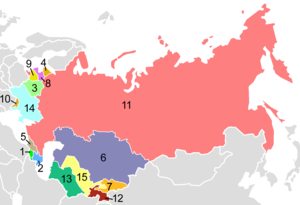Dissolution of the Soviet Union
| | This article's introduction section may not adequately summarize its contents. To comply with Wikipedia's lead section guidelines, please consider expanding the lead to provide an accessible overview(May 2010) of the article's key points. |
| Dissolution of the Soviet Union | |
|---|---|
 Tanks at the Red Square during the 1991 Soviet coup d'etat attempt | |
| Participants | People of the Soviet Union Federal government (AKA "the Centre") Republican governments Autonomous SSRs |
| Location | Soviet Union |
| Date | January 19, 1990—December 26, 1991 |
| Result | Fall of the Soviet Union and independence of its republics |

1. Armenia, 2. Azerbaijan, 3. Belarus, 4. Estonia,
5. Georgia, 6. Kazakhstan, 7. Kyrgyzstan, 8. Latvia,
9. Lithuania, 10. Moldova, 11. Russia, 12. Tajikistan,
13. Turkmenistan, 14. Ukraine, 15. Uzbekistan
Contents[show] |
[edit] Early stages
[edit] Multi-party elections

